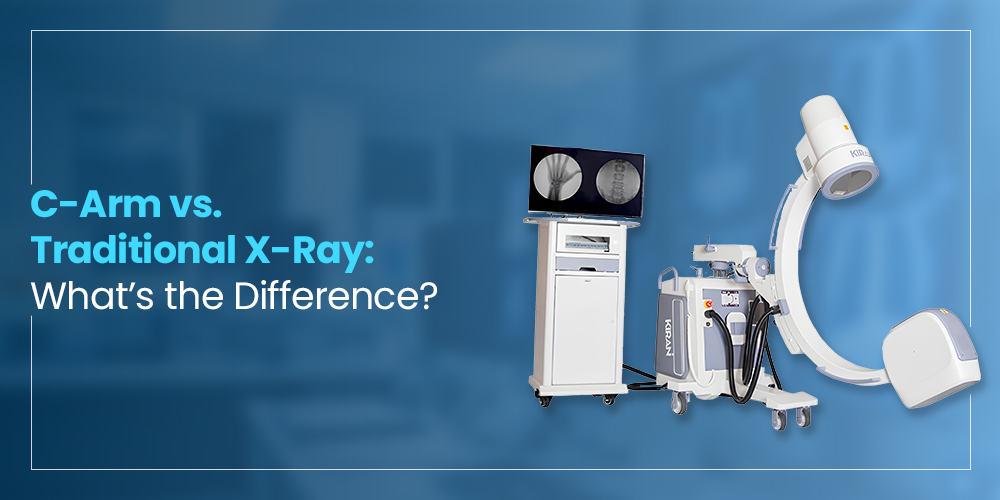Medical imaging has revolutionized healthcare, transforming how professionals diagnose, assess, and treat various medical conditions. Among the many imaging technologies available today, C-Arm machines and traditional X-ray systems are two of the most widely used diagnostic tools.
Understanding the key differences between these two technologies is crucial for medical professionals, hospital administrators, and patients seeking the most effective diagnostic and treatment solutions. This article explores both imaging systems, highlighting their unique characteristics and applications.
Overview of C-Arm and Traditional X-Ray
What is a C-Arm Machine?
A C-Arm machine is a state-of-the-art, portable fluoroscopy imaging system based on X-ray technology. It provides real-time, high-resolution images during medical procedures such as orthopedic, urology, and gastroenterology surgeries, as well as in complex interventional procedures.
The name “C-Arm” comes from its distinctive C-shaped arm, which houses the X-ray source on one end and the detector on the other. This design allows for flexible positioning, enabling physicians to navigate surgeries with precision and accuracy.
What is a Traditional X-Ray?
A traditional X-ray, or radiography, is one of the most commonly used imaging techniques in medicine. It works by passing X-ray beams through the body, which are then recorded on a digital detector or film. Different tissues absorb X-rays to varying degrees, creating a static, two-dimensional image.
While traditional X-rays offer clear imaging, factors such as resolution and contrast can be affected by external conditions.
C-Arm vs. Traditional X-Ray: What Sets Them Apart?
Both C-Arm and traditional X-ray systems serve critical roles in medical imaging, but they have distinct features that make them suitable for different applications. Here’s a closer look at their differences:
1. Imaging Type & Functionality
- C-Arm: Primarily used in operating rooms for real-time imaging, offering continuous fluoroscopic guidance during surgical and interventional procedures.
- Traditional X-Ray: Provides static images, mainly used for diagnosing fractures, lung infections, and other internal conditions that don’t require real-time visualization.
2. Mobility & Flexibility
- C-Arm: Designed for mobility, allowing it to be easily positioned at different angles around the patient for better imaging during surgery.
- Traditional X-Ray: Generally fixed in radiology departments, with limited mobility and a single-plane imaging approach.
3. Primary Applications
- C-Arm: Commonly used in orthopedic surgeries, cardiac interventions, pain management, and other complex procedures requiring real-time imaging.
- Traditional X-Ray: Ideal for diagnosing fractures, lung infections, dental issues, and other general medical conditions.
4. Radiation Exposure
- C-Arm: Uses dynamic X-ray beams, but modern models are equipped with dose optimization features to ensure safety for prolonged use.
- Traditional X-Ray: Emits a lower radiation dose, as it captures a single image per scan.
5. Cost & Accessibility
- C-Arm: More expensive due to its advanced technology and real-time imaging capabilities, making it more common in surgical and interventional settings.
- Traditional X-Ray: More affordable and widely available in hospitals and clinics for routine imaging.
6. Training & Expertise Required
- C-Arm: Requires specialized training for proper positioning, radiation management, and optimal imaging techniques.
- Traditional X-Ray: Easier to operate, with minimal training required for basic imaging procedures.
7. Space & Setup Requirements
- C-Arm: Requires more space, particularly in operating rooms, and involves a more complex setup.
- Traditional X-Ray: Typically, a compact, wall-mounted installation requiring minimal setup for each scan.
Making the Right Choice: C-Arm or Traditional X-Ray?
Understanding these differences allows healthcare professionals to make informed decisions when choosing between a C-Arm and a traditional X-ray system. While both are indispensable in medical imaging, their applications vary significantly:
- Choose a C-Arm if you need real-time imaging for surgical and interventional procedures.
- Choose a Traditional X-Ray for static imaging, such as diagnosing fractures, lung infections, or routine medical assessments.
For healthcare facilities looking to invest in advanced imaging solutions, Trivitron Healthcare offers high-quality C-Arm machines and X-ray systems designed for precision, efficiency, and patient safety. With cutting-edge technology, Trivitron ensures healthcare professionals have the best tools to provide superior patient care.
Need a C-Arm machine for sale? Explore Trivitron Healthcare’s latest medical imaging solutions today!

